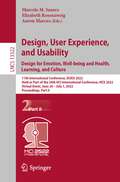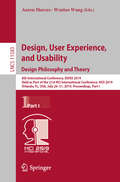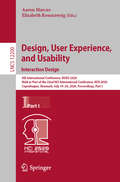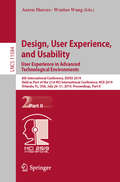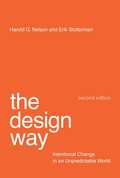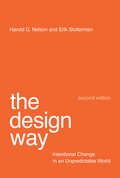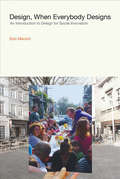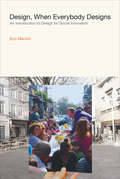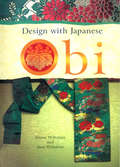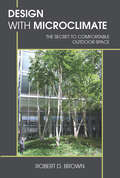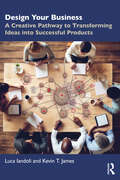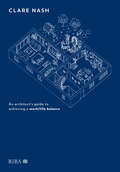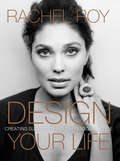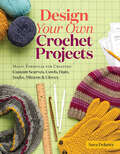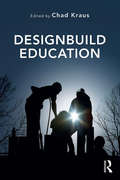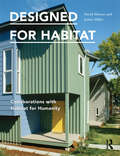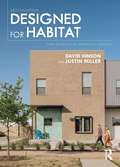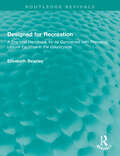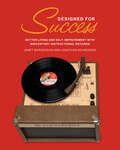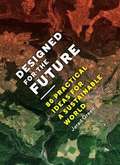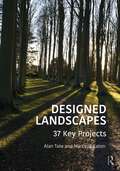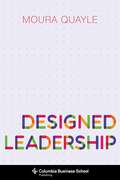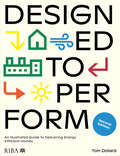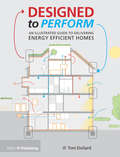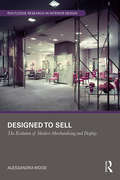- Table View
- List View
Design, User Experience, and Usability: 11th International Conference, DUXU 2022, Held as Part of the 24th HCI International Conference, HCII 2022, Virtual Event, June 26 – July 1, 2022, Proceedings, Part II (Lecture Notes in Computer Science #13322)
by Marcelo M. Soares Elizabeth Rosenzweig Aaron MarcusThis book constitutes the refereed proceedings of the 11th International Conference on Design, User Experience, and Usability, DUXU 2022, held as part of the 23rd International Conference, HCI International 2022, which was held virtually in June/July 2022.The total of 1271 papers and 275 posters included in the HCII 2022 proceedings was carefully reviewed and selected from 5487 submissions. The DUXU 2022 proceedings comprise three volumes; they were organized in the following topical sections: Part I: Processes, Methods, and Tools for UX Design and Evaluation; User Requirements, Preferences, and UX Influential Factors; Usability, Acceptance, and User Experience Assessment. Part II: Emotion, Motivation, and Persuasion Design; Design for Well-being and Health.- Learning Experience Design; Globalization, Localization, and Culture Issues. Part III: Design Thinking and Philosophy; DUXU Case Studies; Design and User Experience in Emerging Technologies.
Design, User Experience, and Usability. Design Philosophy and Theory: 8th International Conference, DUXU 2019, Held as Part of the 21st HCI International Conference, HCII 2019, Orlando, FL, USA, July 26–31, 2019, Proceedings, Part I (Lecture Notes in Computer Science #11583)
by Aaron Marcus Wentao WangThe four-volume set LNCS 11583, 11584, 11585, and 11586 constitutes the proceedings of the 8th International Conference on Design, User Experience, and Usability, DUXU 2019, held as part of the 21st International Conference, HCI International 2019, which took place in Orlando, FL, USA, in July 2019.The total of 1274 papers and 209 posters included in the 35 HCII 2019 proceedings volumes was carefully reviewed and selected from 5029 submissions.DUXU 2019 includes a total of 167 regular papers, organized in the following topical sections: design philosophy; design theories, methods, and tools; user requirements, preferences emotions and personality; visual DUXU; DUXU for novel interaction techniques and devices; DUXU and robots; DUXU for AI and AI for DUXU; dialogue, narrative, storytelling; DUXU for automated driving, transport, sustainability and smart cities; DUXU for cultural heritage; DUXU for well-being; DUXU for learning; user experience evaluation methods and tools; DUXU practice; DUXU case studies.
Design, User Experience, and Usability. Interaction Design: 9th International Conference, DUXU 2020, Held as Part of the 22nd HCI International Conference, HCII 2020, Copenhagen, Denmark, July 19–24, 2020, Proceedings, Part I (Lecture Notes in Computer Science #12200)
by Aaron Marcus Elizabeth RosenzweigThis book constitutes the refereed proceedings of the 9th International Conference on Design, User Experience, and Usability, DUXU 2020, held as part of the 22nd International Conference on Human-Computer Interaction, HCII 2020, in Copenhagen, Denmark, in July 2020. The conference was held virtually due to the COVID-19 pandemic.From a total of 6326 submissions, a total of 1439 papers and 238 posters has been accepted for publication in the HCII 2020 proceedings. The 40 papers included in this volume were organized in topical sections on UX design methods, tools and guidelines, interaction design and information visualization, and emotional design.
Design, User Experience, and Usability. User Experience in Advanced Technological Environments: 8th International Conference, DUXU 2019, Held as Part of the 21st HCI International Conference, HCII 2019, Orlando, FL, USA, July 26–31, 2019, Proceedings, Part II (Lecture Notes in Computer Science #11584)
by Aaron Marcus Wentao WangThe four-volume set LNCS 11583, 11584, 11585, and 11586 constitutes the proceedings of the 8th International Conference on Design, User Experience, and Usability, DUXU 2019, held as part of the 21st International Conference, HCI International 2019, which took place in Orlando, FL, USA, in July 2019.The total of 1274 papers and 209 posters included in the 35 HCII 2019 proceedings volumes was carefully reviewed and selected from 5029 submissions.DUXU 2019 includes a total of 167 regular papers, organized in the following topical sections: design philosophy; design theories, methods, and tools; user requirements, preferences emotions and personality; visual DUXU; DUXU for novel interaction techniques and devices; DUXU and robots; DUXU for AI and AI for DUXU; dialogue, narrative, storytelling; DUXU for automated driving, transport, sustainability and smart cities; DUXU for cultural heritage; DUXU for well-being; DUXU for learning; user experience evaluation methods and tools; DUXU practice; DUXU case studies.
The Design Way: Intentional Change in an Unpredictable World (Second Edition)
by Harold G. Nelson Erik StoltermanHumans did not discover fire--they designed it. Design is not defined by software programs, blueprints, or font choice. When we create new things--technologies, organizations, processes, systems, environments, ways of thinking--we engage in design. With this expansive view of design as their premise, in The Design Way Harold Nelson and Erik Stolterman make the case for design as its own culture of inquiry and action. They offer not a recipe for design practice or theorizing but a formulation of design culture's fundamental core of ideas. These ideas--which form "the design way"--are applicable to an infinite variety of design domains, from such traditional fields as architecture and graphic design to such nontraditional design areas as organizational, educational, interaction, and healthcare design. The text of this second edition is accompanied by new detailed images, "schemas" that visualize, conceptualize, and structure the authors' understanding of design inquiry. The text itself has been revised and expanded throughout, in part in response to reader feedback.
The Design Way, second edition: Intentional Change in an Unpredictable World
by Harold G. Nelson Erik StoltermanA book that lays out the fundamental concepts of design culture and outlines a design-driven way to approach the world.Humans did not discover fire—they designed it. Design is not defined by software programs, blueprints, or font choice. When we create new things—technologies, organizations, processes, systems, environments, ways of thinking—we engage in design. With this expansive view of design as their premise, in The Design Way Harold Nelson and Erik Stolterman make the case for design as its own culture of inquiry and action. They offer not a recipe for design practice or theorizing but a formulation of design culture's fundamental core of ideas. These ideas—which form “the design way”—are applicable to an infinite variety of design domains, from such traditional fields as architecture and graphic design to such nontraditional design areas as organizational, educational, interaction, and healthcare design.The text of this second edition is accompanied by new detailed images, “schemas” that visualize, conceptualize, and structure the authors' understanding of design inquiry. The text itself has been revised and expanded throughout, in part in response to reader feedback.
Design, When Everybody Designs
by Rachel Coad Ezio ManziniIn a changing world everyone designs: each individual person and each collective subject, from enterprises to institutions, from communities to cities and regions, must define and enhance a life project. Sometimes these projects generate unprecedented solutions; sometimes they converge on common goals and realize larger transformations. As Ezio Manzini describes in this book, we are witnessing a wave of social innovations as these changes unfold -- an expansive open co-design process in which new solutions are suggested and new meanings are created. Manzini distinguishes between diffuse design (performed by everybody) and expert design (performed by those who have been trained as designers) and describes how they interact. He maps what design experts can do to trigger and support meaningful social changes, focusing on emerging forms of collaboration. These range from community-supported agriculture in China to digital platforms for medical care in Canada; from interactive storytelling in India to collaborative housing in Milan. These cases illustrate how expert designers can support these collaborations -- making their existence more probable, their practice easier, their diffusion and their convergence in larger projects more effective. Manzini draws the first comprehensive picture of design for social innovation: the most dynamic field of action for both expert and nonexpert designers in the coming decades.
Design, When Everybody Designs: An Introduction to Design for Social Innovation (Design Thinking, Design Theory)
by Ezio ManziniThe role of design, both expert and nonexpert, in the ongoing wave of social innovation toward sustainability.In a changing world everyone designs: each individual person and each collective subject, from enterprises to institutions, from communities to cities and regions, must define and enhance a life project. Sometimes these projects generate unprecedented solutions; sometimes they converge on common goals and realize larger transformations. As Ezio Manzini describes in this book, we are witnessing a wave of social innovations as these changes unfold—an expansive open co-design process in which new solutions are suggested and new meanings are created. Manzini distinguishes between diffuse design (performed by everybody) and expert design (performed by those who have been trained as designers) and describes how they interact. He maps what design experts can do to trigger and support meaningful social changes, focusing on emerging forms of collaboration. These range from community-supported agriculture in China to digital platforms for medical care in Canada; from interactive storytelling in India to collaborative housing in Milan. These cases illustrate how expert designers can support these collaborations—making their existence more probable, their practice easier, their diffusion and their convergence in larger projects more effective. Manzini draws the first comprehensive picture of design for social innovation: the most dynamic field of action for both expert and nonexpert designers in the coming decades.
Design with Japanese Obi
by Diane Wiltshire Ann WiltshireIn Design with Japanese Obi, the authors present the obi as it is being used in interiors today, demonstrating simple yet striking techniques for makingthese exquisite kimono sashes the centerpiece of any room's decor. The focus is on seven key uses for obi that are applicable to nearly any setting imaginable, such as: Artistic table arrangements Dining room accents Framing enhancements Fabric coveringsThese and other dramatic and innovative uses of obi in interior design are presented along with such essentials as color coordination, fabric shaping, and accessories for hanging obi. The vivid photographs in this book present some of the most elegant interiors the authors have found, from Tokyo to Washington, D.C., and show the obi being used in today's homes to create a sumptuous, refined, and modern ambiance.
Design With Microclimate: The Secret to Comfortable Outdoor Space
by Robert D. BrownRobert Brown helps us see that a "thermally comfortable microclimate" is the very foundation of well-designed and well-used outdoor places. Brown argues that as we try to minimize human-induced changes to the climate and reduce our dependence on fossil fuels-as some areas become warmer, some cooler, some wetter, and some drier, and all become more expensive to regulate-good microclimate design will become increasingly important. In the future, according to Brown, all designers will need to understand climatic issues and be able to respond to their challenges. Brown describes the effects that climate has on outdoor spaces-using vivid illustrations and examples-while providing practical tools that can be used in everyday design practice. The heart of the book is Brown's own design process, as he provides useful guidelines that lead designers clearly through the complexity of climate data, precedents, site assessment, microclimate modification, communication, design, and evaluation. Brown strikes an ideal balance of technical information, anecdotes, examples, and illustrations to keep the book engaging and accessible. His emphasis throughout is on creating microclimates that attend to the comfort, health, and well-being of people, animals, and plants. Design with Microclimate is a vital resource for students and practitioners in landscape architecture, architecture, planning, and urban design.
Design Your Business: A Creative Pathway to Transforming Ideas into Successful Products
by Luca Iandoli Kevin T. JamesThis actionable and lively guide helps aspiring entrepreneurs to acquire a designer’s mindset to transform ideas into successful products, and designers and technologists to identify entrepeneurial opportunities through a unique mix of product and business development toolkits.Unlike other books focusing either downstream on the launch of a new venture or upstream on ideation and the acquisition of an entrepreneurial mindset, Design Your Business helps innovators to cross the chasm between attractive ideas and actual products, a crucial test in any entrepreneurial endeavor and one which most innovative ideas do not pass. Throughout the book, readers will learn about methods, steps, and resources to unleash their creativity, understand users’ needs, build and test prototypes, and design beautiful products. At the end of this design journey, readers will find an essential business toolkit including business model design, intellectual property protection, funding, and development of effective communication skills that will help them to lay the foundation of a successful venture built around a successful product.This book will become an essential and thought-provoking resource for aspiring entrepreneurs, makers, students of entrepreneurship and new venture creation, and professionals seeking to adopt a design mindset and agile project management in their projects and organizations.Slides and teaching materials based on this book are curated from the authors and available for free at this link: https://elegantdesignthinking.com/category/learning-resources/
Design your life: An architect’s guide to achieving a work/life balance
by Clare NashTen years ago, Clare Nash was struggling with a common problem: how to be an architect and still have a life. With no job, no savings and no clients in the midst of a recession, Clare set up her own practice with little more than a few postcards in local shop windows and a very simple website. Determined to better combine her life and family with professional work, she created an innovative practice that is flexible and forward-looking, based around remote working and the possibilities offered by improving technology. Bursting with tips, ideas and how-tos on all aspects of designing a working life that suits you and your business, this book explains in clear and accessible language how to avoid the common pitfalls of long hours and low pay. It explores how to juggle work with family commitments, how to set your own career path and design priorities, and how to instil a flexible working culture within a busy lifestyle. Encompasses the full range of life-work challenges: Money, fees and cashflow Playing to your personal strengths Outsourcing areas of weakness Building a happy and productive remote-working team Creating a compelling marketing strategy Juggling parenthood and work Studying and honing workplace skills Provides the inside view from innovative practices: alma-nac, Gbolade Design Studio, Harrison Stringfellow Architects, Invisible Studio Architects, Office S&M Architects, POoR Collective, Pride Road Architects and Transition by Design.
Design Your Life: Creating Success Through Personal Style
by Rachel RoyThe internationally renowned designer and entrepreneur helps women look and be the very best version of themselves with this strong, sexy style guide filled with practical and inspirational tips and personal insights gleaned from her own journey in life and business. “As a teen, I’d draw the type of glamorous clothes and accessories I longed for. In retrospect I realize that I was a designing the life I wanted and would one day achieve. ” As a designer, entrepreneur, philanthropist, and working mother, Rachel Roy has a unique perspective on how fashion defines who we are—and who we want to be. Growing up in a low-income neighborhood in California, she envisioned the life she lives today. The head of her own fashion business, she’s a successful, hard-working entrepreneur who believes through style we can help design the life we want to live. Design Your Life is the embodiment of Rachel’s ethos—a style guide every woman, no matter what stage of life she is in, needs to help her define and implement her personal look, motivate her to focus on the person she wants to be and the job she aspires to have, and make choices based on where she wants to go. Rachel offers hands-on tips for developing personal style while staying true to yourself, using and updating what’s in your closest, and adding essential pieces to your wardrobe. Throughout, she shares stories from her own life and the vital role fashion and style has played each step of the way. Elegantly designed and illustrated with more than fifty exclusive color line drawings, filled with her passion, vision, and commitment to empowerment, Design Your Life takes fashion one step further—from looking great to becoming great, from the inside out.
Design Your Own Crochet Projects: Magic Formulas for Creating Custom Scarves, Cowls, Hats, Socks, Mittens & Gloves
by Sara DelaneyYou love to crochet, but you’re tired of the granny square and other predictable projects. Let celebrated crochet teacher Sara Delaney help you expand your skills while showing you how to create custom-fit wearable accessories. Delaney’s unique, flexible formulas let crocheters of all levels easily design scarves, cowls, fingerless mitts, mittens, gloves, hats, and socks. With fill-in-the-blank templates and a stitch dictionary, you can use your favorite yarn and stitch pattern, and make accessories that fit perfectly. Delaney offers a starter course in the technique with 18 of her own original patterns, along with the formulas she used to create them. The companion online calculator helps create your customized patterns even more quickly!
Designbuild Education
by Chad KrausDesignbuild Education adopts the intellectual framework of American Pragmatism, which is a theory of action, to investigate architects’ compelling urge to build and how that manifests in collegiate designbuild programs. Organized into four themes—people, poetics, process, and practice—the book brings together new essays by some of today’s most well-known designbuild educators, including Andrew Freear from Rural Studio and Dan Rockhill from Studio 804, to shed light on the theoretical dimensions of their practice and work. Illustrated with over 100 black and white images.
Designed for Habitat: Collaborations with Habitat for Humanity
by David Hinson Justin MillerIf you're looking for ways to give back to your community, then this book, the first to profile thirteen projects designed and built by architects and Habitat for Humanity, will help. Detailed plans, sections, and photographs show you how these projects came about, the strategies used by each team to approach the design and construction process, and the obstacles they overcame to realize a successful outcome. The lessons and insights, presented here will aid you, whether you're an architect, architecture student, Habitat affiliate leader, or an affordable housing advocate. Located all across the United States, these projects represent the full spectrum of Habitat for Humanity affiliates, from large urban affiliates to small rural programs. These cases illustrate a broad range of innovative approaches to energy performance, alternative construction strategies, and responses to site context. And each house demonstrates that design quality need not fall victim to the rigorous imperatives of cost, delivery, and financing.
Designed for Habitat: New Directions for Habitat for Humanity
by David Hinson Justin MillerDesigned for Habitat: New Directions for Habitat for Humanity presents 12 new projects designed and built via collaborations between architects and Habitat for Humanity®. The ways in which we think about affordable housing are being challenged by designers and not-for-profit housing advocates such as Habitat for Humanity and its affiliates. The projects chronicled in this book consider home affordability through the lens of monthly homeownership expenses, energy efficiency and residential energy use, and issues of designed resilience to natural events ranging from aging and accessibility concerns to natural disasters and climate change. New to this edition, the projects reflect new approaches to building scale, construction technology, energy and affordability, and design and context. Illustrated with over 100 color images, the case studies include detailed plans and photographs to show how these projects came about, the strategies used by each team to approach the design and construction process, and the obstacles they overcame to realize a successful outcome. The lessons and insights presented will be a valuable resource, whether you’re an architect, an architecture student, a Habitat affiliate leader, or an affordable housing advocate.
Designed for Recreation: A Practical Handbook for All Concerned with Providing Leisure Facilities in the Countryside (Routledge Revivals)
by Elisabeth BeazleyOriginally published in 1969, at a time when there was an ever-increasing number of people going to the coast and countryside at weekends and on holiday, this book filled a gap by providing detail on the physical results of all that needed to be done for the leisure-seeking public. It discusses juggling the needs of the public whilst maintaining the quality of the natural environment – a balancing act which remains as relevant in the 21st Century as when the book was first published. The book is intended for all those making provision for public recreation and countryside protection. The passing of the Countryside Act in 1968 in the UK necessitated detailed work for local authorities: the design and siting of car parks; public lavatories; litter bins, camp and picnic sites; swimming pools and information centres to name but a few. Elisabeth Beazley discusses the principles involved and illustrates successful and cautionary examples from both sides of the Atlantic as well as Continental Europe
Designed for Success: Better Living and Self-Improvement with Midcentury Instructional Records
by Janet Borgerson Jonathan SchroederA charmingly illustrated history of midcentury instructional records and their untold contribution to the American narrative of self-improvement, aspiration, and success.For the midcentury Americans who wished to better their golf game through hypnosis, teach their parakeet to talk, or achieve sexual harmony in their marriage, the answers lay no further than the record player. In Designed for Success, Janet Borgerson and Jonathan Schroeder shed light on these endearingly earnest albums that contributed to a powerful American vision of personal success. Rescued from charity shops, record store cast-off bins, or forgotten boxes in attics and basements, these educational records reveal the American consumers&’ rich but sometimes surprising relationship to advertising, self-help, identity construction, and even aspects of transcendentalist thought.Relegated to obscurity and novelty, instructional records such as Secrets of Successful Varmint Calling, You Be a Disc Jockey, and How to Ski (A Living-Room Guide for Beginners) offer distinct insights into midcentury media production and consumption. Tracing the history of instructional records from the inception of the recording industry to the height of their popularity, Borgerson and Schroeder offer close readings of the abundant topics covered by &“designed for success&” records. Complemented by over a hundred full-color illustrations, Designed for Success is a wonderfully nostalgic tour that showcases the essential role these vinyl records played as an unappreciated precursor to contemporary do-it-yourself culture and modern conceptions of self-improvement.
Designed for the Future
by Jared GreenIn Designed for the Future, author Jared Green asks eighty of today's most innovative architects, urban planners, landscape architects, journalists, artists, and environmental leaders the same question: what gives you the hope that a sustainable future is possible? Their imaginative answers--covering everything from the cooling strategies employed at Cambodia's ancient temple city of Angkor Wat to the use of cutting-edge eco-friendly mushroom board as a replacement for Styrofoam--show the way to our future success on earth and begin a much-needed dialogue about what we can realistically accomplish in the decades ahead. Featuring an international roster of leading design thinkers including:* Biomimicry pioneer Janine Benyus* Curator Barry Bergdoll* Educator and author Alan Berger* Environmentalist and author Lester Brown* Architect Rick Cook* Urban Planner Paul Farmer* Critic Christopher Hume* Architect Bjarke Ingels* Landscape designer Mia Lehrer* Architect Rob Rogers* Critic Inga Saffron* Artist Janet Echelman
Designed Landscapes: 37 Key Projects
by Alan Tate Marcella EatonDesigned Landscapes is a case-by-case study of 37 significant, existing works of landscape design worldwide, largely constructed since the Renaissance. Being an informative and easy-to-read reference volume for practitioners and students alike, it presents key precedents in landscape architecture using site plans and recent photographs to showcase each project. Organised and presented in 12 sections based on project type, each project is examined based on date, previous site condition, designer(s), design intentions, current composition, unique features, ownership and management, and comparable projects. Each chapter offers an insightful critique of the featured projects. Written by the authors of Great City Parks, the book posits that these carefully selected key projects have maintained their status throughout the ages because they express values and design intentions that continue to inform the practice of the landscape architecture in the present day. The book concludes with a ten-point summary of lessons for professional practice gleaned from the studies. Including a wide range of case studies from countries including many in western Europe, the United States, Canada, India, Japan and China, and lavishly illustrated with over 200 full-colour images, the book is a must-have volume for anyone interested in the history and current practice of landscape architecture.
Designed Leadership (Columbia Business School Publishing Ser.)
by Moura QuayleGreat leaders aspire to manage “by design”—with a sense of purpose and foresight. But too few leaders incorporate the proven practices and principles of the design disciplines. Lessons learned from the world of design, when applied to management, can turn leaders into collaborative, creative, deliberate, and accountable visionaries. Design thinking loosens the mind and activates innovation. It creates the conditions for employees to thrive and for all kinds of businesses to succeed. In Designed Leadership, the strategic-design scholar and urban-systems designer Moura Quayle shares her plan for integrating design and leadership, translating processes, principles, and practices from years of experience into tools of change for professional leaders. Quayle describes the key concepts of designed leadership, such as “make values explicit” and “learn from natural systems,” showing how strategic design can spur individual creativity and harness collective energy. For managers at any level, Designed Leadership uses original visuals and field-tested examples to teach the kind of thinking, theorizing, and practicing that result in long-lasting high performance in the workplace and beyond.
Designed to Perform: An Illustrated Guide to Delivering Energy Efficient Homes
by Tom DollardHow do we ensure sustainable buildings perform as intended? The performance gap between predicted and actual energy use in new homes has been identified as key problem by government and industry experts. This updated edition is an illustrated practical design guide to delivering better energy performance in all types of new build homes. It introduces readers to the concept of the performance gap and highlights clear issues and solutions to help architects improve their detailing at design stage. The book: Features annotated details with photos taken from live construction sites Includes accessible practical guidance for busy practitioners Raises construction quality and performance of new homes Promotes the case for more architect supervision throughout the construction process A new chapter features innovative low carbon building methods, including hempcrete blocks, clay blocks and straw bale. All information has been updated to reflect the latest data with fresh details and technologies.
Designed to Perform: An Illustrated Guide to Providing Energy Efficient Homes
by Tom DollardThis book is an illustrated practical design guide to delivering better energy performance in all types of new build homes. It takes the form of an annotated details book, with photos taken from live construction sites, with the content based around diagrams, drawings and photos by the author, which demonstrates valuable best practice knowledge and advice. Chapter 1 is an introduction to the performance gap and the quality of design and construction in new build homes, explaining the typical construction sequence of homebuilding, and highlights common issues that designers need to engage with. Chapters 2-7 look at each construction fabric in turn, including a series of detailed drawings, diagrams and photos illustrating the key elements of good design. Chapter 8 contains a checklist of all performance gap issues that designers need to look for. This book will provide valuable guidance to architects and designers on how to improve their detailing at construction stage, and therefore the overall quality of design and performance of new homes.
Designed to Sell: The Evolution of Modern Merchandising and Display (Routledge Research in Interior Design)
by Alessandra WoodDesigned to Sell presents an engaging account of mid-twentieth-century department store design and display in America from the 1930s to the 1960s. It traces the development of postwar philosophies of retail design that embodied aesthetics and function and new modes of merchandise display, resulting in the emergence of a new type of industrial designer. The evolution of aesthetics in department stores during this period reflected larger cultural shifts in consumer behaviour and lifestyle. Designed to Sell explores these changes using five key case studies and original archival sources to reveal the link between designers and consumption beyond the design of individual objects. It argues that design is not simply connected to retail consumption, but that it is capable of controlling how and where customers shop and what they are drawn to purchase. This book contextualises this discussion and brings it up to date for students and scholars interested in design, retail, and interior history.
